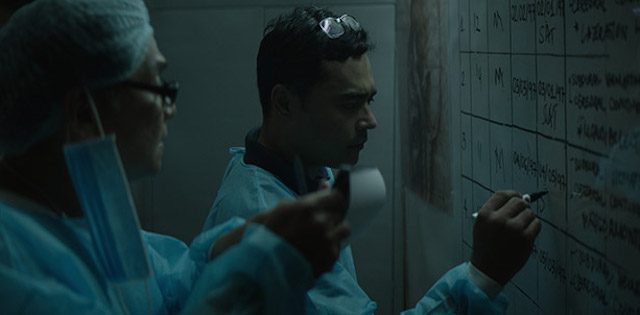“Smaller and Smaller Circles” explores the idea of a serial killer in our midst. It does so by weaving a riveting tale of sadistic murder and mystery, and brings an unusual, eerie sense of pleasure, but pleasure nonetheless.
A murder mystery is hard to resist, especially when the setting is the society you live in — modern-day, third world Philippines, in the slums of Payatas; and the perpetrator conducts his business with precision and an ounce of sophistication, mutilating victims in consistent fashion. It draws you in, and you find yourself open-mouthed in wonder, eager for the mystery to unfold.
At first it unfolds slowly, peppered with conversations between two passionate Jesuit priests — Father Gus Saenz (Nonie Buencamino)and his able sidekick, Father Jerome Lucero (Sid Lucero) — as they try to figure out clues to unravel the identity of the killer.
With visual cues, the film tries to mislead regarding the identity of the suspect. Storytelling takes a relaxed pace initially, taking you for a slow ride, up until it pulls all the curtains and everything slides easily to reveal who the killer is.
Apart from the plot, the biggest attraction of the film are Buencamino and Lucero’s portrayals of the two priests. They are at the same time exacting and charming, and proof that you don’t need blockbuster stars to deliver stunning lead performances and make a good film.
There are other memorable characters played by actors who seamlessly fit the bill: NBI Director Lastimosa as played by Bembol Roco; Cardinal Meneses as portrayed by Ricky Davao; and the incurable Ben Arcinas, played by Raffy Tejada.
Carla Humphries is a pleasant surprise as journalist Joanna Bonifacio. It’s not hard to imagine her as a strong-willed, spirited young woman who was schooled in the finest institutions. She was every bit the highly educated and spirited, but it seemed she didn’t have as much room to explore and play up her gritty reporter bit.
Throughout the course of the film, one is led to believe that not all murderers kill not only because they want to rob someone; earn money as gun for hire; or because they got high on drugs, raped someone and wanted to conceal what they’ve done.
There is strange comfort that people are inherently good and in the idea that people kill not only because they want to. There is something romantic in the thought that there is a deeper yet twisted reason — a perfectly logical although unjustifiable explanation — for why someone would perpetrate the unthinkable.
Based on the award-winning crime novel of the same title by F.H. Batacan, the film takes us to this alternate universe where serial killers exist and English-speaking, well-meaning, well-trained and incorruptible people like Father Saenz, a forensics anthropologist, and Father Lucero, a clinical psychologist, are allowed to contribute to society because the authorities don’t know shit about what they’re doing and because our government can barely invest in competent personnel.
So yes, in as much as “Smaller and Smaller Circles” gives us a bleak yet affirming view of our imperfect society; it also reflects societal ills that have been plaguing our country for the longest time. Corruption and incompetence in the government. Sexual abuse and abuse of power. Poverty and injustice.
It even exposes anomalies within the Catholic Church, although touches on them only momentarily. “Smaller and Smaller Circles” presents these issues layer upon layer, one evil linking to the next.
Thanks to the film’s cinematography, it feels dreary and haunting all throughout, with barely a sparkle of hope escaping to the surface. Wolfgang’s “Mata ng Dios” plays even as the worst has happened, as if questioning the validity of God’s presence.
With every single thing that goes wrong and leads to another and yet another fault, a child suffers or a young boy is killed. This is a painful, indirect truth that we discover through the film, a cross we have to bear: whenever an older generation messes things up, it’s the younger generation who pays for it. One mistake can lead to bigger problems, cost lives, or even more.
“Smaller and Smaller Circles” is gripping and compelling, and should find favor with moviegoers who feel that they deserve something different and more artful from what local mainstream cinema can offer.
Given that most of the dialogue is delivered in English, however, it might feel foreign and intimidating to general audiences. Nonetheless, it is an extraordinary film that deserves more screen time than others and a step towards upgrading standards in Philippine cinema.







